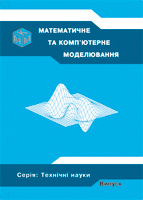Method of Restoration of Input Signals of Nonlinear Dynamic Object with Destributed Parameters
DOI:
https://doi.org/10.32626/2308-5916.2018-18.65-73Анотація
The article deals with the method of signal restoration at the input of a nonlinear dynamic object with distributed parameters. To describe these objects, a universal mathematical model in the form of a Volterra integro-degree series has been chosen. The problem of signal restoration is reduced to the problem of solving the Volterra polynomial equation of the first kind. The numerical implementation of such models is suggested to be carried out using quadrature methods, in particular, the method of trapezoids. In order to increase the stability of the solution in the presence of noise interference in the input data, it is suggested to use the differential regularization operator, which allows the incorrectly set task to be transformed into a class of correct ones. The possibility of applying such an approach is studied in solving the Volterra polynomial integral equation of the second order type, which describes nonlinear dynamic objects with quadratic nonlinearity. The computational formulas for solving this type of equations are given in the article. The received nonlinear second-order algebraic equations after approximation of the initial equation by integral sums are solved by iterative methods with initial approximation in the form of a pre-calculated radical. The developed algorithms are implemented as software modules in the Matlab, with the help of which a number of computational experiments have been carried out. As an example, non-linear dynamic objects that contain static non-linearity of the second order and dynamic links that are typical for objects with distributed parameters have been chosen. Such links are: a semi-integral link, an attenuation link (semi-delay) and a semi-inertial link. On the basis of applying the equivalent transformations, the macromodels of objects with distributed parameters have been obtained in the form of a polynomial integral Volterra equation of the I kind of the second order with the kernels that describe the above-mentioned components. The results of the computational experiments, presented in the form of graphs, showed that the suggested approach can be effectively used in restoration of signals at the input of nonlinear dynamic objects with distributed parameters.
Посилання
Ivaniuk V. А. Integral models of irrational and transcendental links / V. А. Ivaniuk, V. О. Tykhokhod, S. О. Protasov // Mathematical and computer simulation. Series: Engineering sciences : collection of research papers / Kami-anets-Podilskyi National Ivan Ohiienko University, V. M. Hlushkov Institute of Cybernetics of the National Academy of Sciences of Ukraine, Kamianets-Podilskyi : Kamianets-Podilskyi National Ivan Ohiienko University, 2011. — ISSUE 5. — P. 101–109.
Ivanyuk V. Solving inverse problems of dynamics of nonlinear objects based on the Volterra series / V. Ivanyuk, V. Ponedilok, J. Sterten // Computational problems of electrical engineering — Lviv : Lviv Polytechnic National University, 2016. — Vol. 6, No. 1. — P. 9–16.
Ponedilok V. Regularization Method of Restoration of Input Signals of Nonline-ar Dynamic Objects that Determined by Integro-Degree Volterra Series / V. Ponedilok // Mathematical and computer modelling. Series: Technical sciences: scientific journal / V. M. Glushkov Institute of Cybernetics of the National Academy of Sciences of Ukraine, Kamianets-Podilskyi National Ivan Ohiienko University. — Kamianets-Podilskyi : Kamianets-Podilskyi National Ivan Ohiienko University, 2018. — ISSUE 17. — P. 133–140.
Pupkov K. А. Functional series in the theory of nonlinear systems / К. А. Pupkov, V. I. Kapalin, А.S. Yushchenko. — М. : Nauka, 1976. — 448 p.
Solodusha S. V. Simulation of automatic control systems based on Volterra polynomials / S. V. Solodusha // Simulation and analysis of information systems. — 2012. — № 1. — P. 60–68.
Verlan A. F. Integral equations: Methods. Algorithms. Programs: Reference book / A. F.Verlan, V. S. Sizikov. — К. : Nauk. dumka, 1986. — 548 p.
##submission.downloads##
Опубліковано
Номер
Розділ
Ліцензія
Authors who publish with this journal agree to the following terms:- Authors retain copyright and grant the journal right of first publication with the work simultaneously licensed under a Creative Commons Attribution License that allows others to share the work with an acknowledgement of the work's authorship and initial publication in this journal.
- Authors are able to enter into separate, additional contractual arrangements for the non-exclusive distribution of the journal's published version of the work (e.g., post it to an institutional repository or publish it in a book), with an acknowledgement of its initial publication in this journal.
- Authors are permitted and encouraged to post their work online (e.g., in institutional repositories or on their website) prior to and during the submission process, as it can lead to productive exchanges, as well as earlier and greater citation of published work (See The Effect of Open Access).

